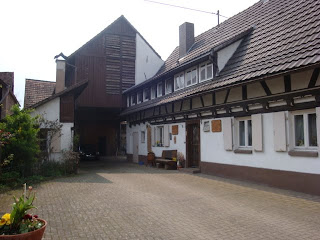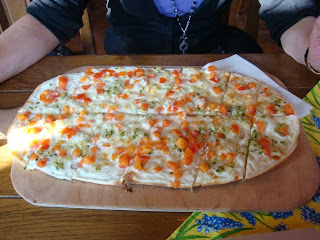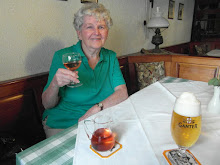The Schwarzer Adler in mid March
We had driven down to Oberbergen, the small town in which the restaurant is located in the Kaiserstuhl, to reserve a table a week prior to my birthday. Not that we couldn't have phoned, but we prefer booking in person. That is always part of the enjoyment beforehand. One passes through some lovely wine villages and over some steep grapevine-terraced hills that comprise this slate covered area that is known as the Kaiserstuhl (literally translated it means the emperor's chair). It was formed by an erupting volcano many eons ago. It isn't far, just 35 minutes southwest of us.
Below, the small, medieval walled town of Burgheim. It is located just a few kilometers from Oberbergen. I will write about this town and others another time.
Below, later in March, with a pause amidst spring-blooming bushes and trees in the vineyards
The Kaiserstuhl is an area slightly northwest of Freiburg--a university city of about 200,000--and rises like a mountain spur from the valley around it. It is the warmest area in Germany and is renowned for its wines, fruit and picturesque villages. Most grape vines are planted facing south and as you drive along the narrow, curving roads, the terraced vineyards almost surround you, some below and some above, depending on where you are at any given time. The Romans, it is believed, planted the first grape vines there over 2,000 years ago on their way north.
The Kaiserstuhl is not only well known for its wine but also for its fine cuisine. You'll find many excellent restaurants and Gasthaeuser in the towns scattered over this region and any of them can be reached within minutes of another. Many of those restaurants own vineyards and thus offer their own wines. Oberbergen, in the heart of the Kaiserstuhl, has been a Weinort (wine town) for hundreds of years and is well known for its wines. The Schwarzer Adler in Oberbergen is as well.
Franz Keller, who inherited a more simple Gasthaus from his father many years ago, turned it into one of the finest hotel-restaurants in the Kaiserstuhl and, in fact, in this part of Germany. He also turned it into a wine operation with the largest restaurant wine cellar in southern Germany. His son, Fritz, took over the restaurant when his father died two years ago and is upholding the tradition of what is the oldest Gasthaus in the Kaiserstuhl. (The first mention of a Gasthaus on this site was in the middle 1400s.) He headed the vineyards and the wine making for some years--still an important part of their business--before he and his wife began running the hotel-restaurant. The restaurant and the winery stock many of the finest Bordeaux and Burgundies and, as well, their own well-known dry whites and reds. If wished, you can buy their wines at their small store beside the Gasthaus.
Below, I am standing at the main entrance to the Gasthaus
 I first enjoyed going to the Schwarzer Adler in the mid 1970s when I lived in the Canadian military community in Lahr with my husband and family. The restaurant at that time was a Michelin 2-star. It became my husband's and my favourite.
I first enjoyed going to the Schwarzer Adler in the mid 1970s when I lived in the Canadian military community in Lahr with my husband and family. The restaurant at that time was a Michelin 2-star. It became my husband's and my favourite.During those years, the maitre d'hotel was quite a character. He had traveled the world, working in various restaurants, so had many stories to tell. We had gotten to know him, and on each visit we received special service. Unfortunately, I no longer remember his name, but I do remember that he was outgoing and would try to talk us into a wine he thought was extra-fine--though not necessarily extra expensive. My sister Anne's then partner was most unhappy when they went there for lunch (on my recommendation) during a visit to Germany in the mid 1970s. That same maitre d' hotel tried to talk Michael into a particular wine, one he did not wish. Michael became annoyed. He did not enjoy his lunch that day! On our own visits there, we took it all with a grain of salt and just enjoyed the repartee back and forth, sometimes taking his suggestion and sometimes not.
Below, one of the dining rooms with a glimpse of our table in the forefront
During that same era, my husband's Commanding Officer, Gerry, was not sure he wanted to go to the restaurant, as he thought it was too expensive. But then, he usually suggested one just as expensive himself, such as the Ritter in Durbach (also a two-star restaurant at that time) or the Hirschen in Glottertal. Five couples (the five men all worked at the same unit at Canadian Forces Base Lahr) got together each month and outdid themselves finding special Gasthaeuser or fine restaurants in which to dine on those occasions. Each month, one couple chose the restaurant and the husband chose the wine for the evening. We finally talked Gerry into going to the Schwarzer Adler by picking that restaurant for one of our monthly get togethers. The other three men were on our side! The women were, too, including Peggy, Gerry's wife.
Below, the head waiter is curing the wine glasses with the sommelier (wine stewart) looking on
 We had a beautiful dinner that evening in the 70s. Though that was long ago now, I well remember what Peggy ordered. Peggy asked for lamb. When she ordered it, she asked for French fries instead of the Kartoffel gratin (potatoes gratin) that accompanied the lamb. Our maitre d' (yes, the same one) then said, with eyebrows slightly raised: "Madam," he said, "you can have French fries anywhere, but not at the Schwarzer Adler!" Peggy, being the nice person she was, just smiled and agreed. I'm sure she was pleased she did as the gratin was outstanding. The lamb was so plentiful that it was impossible for her to eat it all. It had come on a large platter surrounded by fresh vegetables. When the maitre d' asked Peggy if he could pass it around to the rest of us, I took a little. It was superb. (I don't remember my own choice that night, though it might have been duck, as I have that whenever it is offered and I have had it there.)
We had a beautiful dinner that evening in the 70s. Though that was long ago now, I well remember what Peggy ordered. Peggy asked for lamb. When she ordered it, she asked for French fries instead of the Kartoffel gratin (potatoes gratin) that accompanied the lamb. Our maitre d' (yes, the same one) then said, with eyebrows slightly raised: "Madam," he said, "you can have French fries anywhere, but not at the Schwarzer Adler!" Peggy, being the nice person she was, just smiled and agreed. I'm sure she was pleased she did as the gratin was outstanding. The lamb was so plentiful that it was impossible for her to eat it all. It had come on a large platter surrounded by fresh vegetables. When the maitre d' asked Peggy if he could pass it around to the rest of us, I took a little. It was superb. (I don't remember my own choice that night, though it might have been duck, as I have that whenever it is offered and I have had it there.)The picture at right shows Herr Pfingsttag, the maitre d'hotel for the past 20 years or so, speaking to Hans.
Several years after I had returned to Germany to work and live, Hans and I went to the Schwarzer Adler for the first time since those 1970s' days. That occasion was also to celebrate a special birthday of mine. That was 15 years ago and we've gone just about every year since. (French fries are still not part of their special menu and as much as I like them myself, I much prefer their potato gratin, Roesti when they have it (Swiss-style Bratkartoffeln) or croquettes when having a special dinner.)
That maitre d'hotel of the 1970s is long gone from the restaurant, but the present maitre d' hotel, whom we've gotten to know in these past years, always remembers us and makes sure we get a good table. Another reason for reserving in person. Hans has had many conversations with Herr Pfingsttag who is Alsatian and has been at the Schwarzer Adler for over 20 years.
Another view of the dining room below left

For the past number of years the Schwarzer Adler has been a one-star Michelin restaurant. The food is as good as ever, although not as generous in the servings as in earlier days--but certainly enough. It is beautifully decorated with oil paintings, flowers in large bowls, magnificent draperies at the windows, wood-paneling on the walls and wooden beams overhead. The snow-white tablecloths and napkins, gleaming silverware and wine glasses all make for a wonderful relaxing atmosphere. The only word for it: Gemuetlich!
We usually order from the Feinschmeckermenue (gourmet menu), though in the 1970s none of us did. Then, we ordered a la carte. For a special occasion--and going only once a year means it is--we order the five- to seven-course menu and spend about four hours enjoying the meal, the wine and the ambience. We keep saying we'll go again before long and order a la carte; perhaps we shall, but then, the time goes by quickly and the next year always arrives before we know it.
 This year we ordered the five-course Feinschmeckermenue, our head waiter being a young man from northern Germany who had finished his training four years ago and was now a full-fledged Oberkellner (head waiter). Herr Felix Wallenhorst was full of good humour and went out of his way to please us. (He is pictured at right.) I started with a glass of Sekt (German-style Champagne) and Hans, a beer.
This year we ordered the five-course Feinschmeckermenue, our head waiter being a young man from northern Germany who had finished his training four years ago and was now a full-fledged Oberkellner (head waiter). Herr Felix Wallenhorst was full of good humour and went out of his way to please us. (He is pictured at right.) I started with a glass of Sekt (German-style Champagne) and Hans, a beer.For the main course, Hans chose a bottle of red, a 2001 Beaujolais Villages, recommended by Paul Bocuse, the renowned three-star chef and food writer in France. (One of our favourite Bordeaux wines we had here for the first time on another occasion was a Chateau Cos d'Estournel. Hans bought a case of it sometime later at a wine fair in France to enjoy at home, at which time Bordeaux wines were more reasonably priced.)
The picture above is of the Beaujolais we had with our main course. This was decanted.
Our meal started with three various canapes, served separately, all of those "on the house." An assortment of fresh bread and butter in small dishes accompanied the canapes and the following first two courses. Below, freshly made cheese sticks, my Sekt and Hans' beer.
The first course was Lachs (salmon) with melon. See below.
The second course was Rotbarbe (ocean perch) with a green asparagus sauce; the skin was crisp and the sauce delicious.
Hans' main course was beef fillet; mine, lamb with a Krauter (herb) and Riesling wine sauce. Excellent. (The lamb was offered on the special menu, but the restaurant is always willing to substitute if not to your liking, thus Hans had the beef instead.) I forgot by that point to take pictures as we were too busy enjoying our food!

After our main course came Brie cheese with a filling which included nuts and served with French bread.
Our last course was dessert, a superb frozen raspberry concoction with a bombe on top, decorated especially for me because of my birthday.
Hans believes--and so do I--that when a dinner or a wine isn't right, one should say something to the owner or waiter. Not every time you think it isn't up to par, but when you know something is definitely wrong. We also believe that one should compliment a chef, waiter or owner for good food and service when it is above the norm or after a very enjoyable dinner. In our experience, both have proven to be worth it. Most chefs and owners do take both criticism and compliments to heart as they have pride in their business and wish to please their guests. It can help to improve the service and food for future guests and you will be remembered next time you go--with a smile.
This picture is of Hans and I one year earlier, in March 2009 - we're almost the same!
The Schwarzer Adler is a restaurant for a special occasion--or all occasions. Across the street, their Rebstock Winzerhaus is a very pleasant Gasthaus with reasonable prices and a regional cuisine. We haven't yet eaten there, but we have stopped in during an afternoon drive for a drink. We look forward to having a meal there in the future.








































